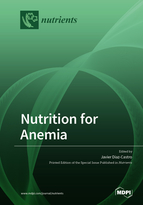Nutrition for Anemia
A special issue of Nutrients (ISSN 2072-6643). This special issue belongs to the section "Nutrition and Public Health".
Deadline for manuscript submissions: closed (30 April 2020) | Viewed by 67956
Special Issue Editor
Interests: pregnancy; lactation; nutrition; perinatal nutrition; pregnancy; oxidative stress; antioxidant system; inflammation; physical activity; endocrine function; early programming
Special Issues, Collections and Topics in MDPI journals
Special Issue Information
Dear Colleagues,
Iron deficiency is extremely common and is the most widespread nutritional deficiency in the world, therefore any nutritional strategy to overcome this pathology can be of high interest. To more fully understand iron deficiency anemia, consideration must be directed toward concepts of iron supply and demand for the production of erythrocytes. Erythropoiesis-related demands for iron are created by three variables: tissue oxygenation, erythrocyte turnover, and erythrocyte loss from hemorrhage. Anaemia takes place when the levels of Fe decrease or the requirements overcome the contribution of the intake that is provided in the diet, so the Fe storages of the organism are depleted. There is no doubt that the Fe deficiency is the major cause of the great majority of anaemias although other minerals or vitamins can be also responsible of this pathology. The Fe-deficiency anaemia is characterized by low levels of serum Fe and hemoglobin (Hb), reduction of the hematocrit and increased levels of platelets, low percentage of transferrin saturation, decrease of serum ferritin and a drastic increase in total Fe binding capacity. In addition, the chemical properties of Fe render it a potential hazard within the organism in that ferrous Fe can catalyze the production of reactive oxygen species (ROS), which in turn can lead to peroxidation and radical chain reactions with molecular damage. Regulation of ROS levels and oxidative stress is extremely important in erythropoiesis. Starting at the basophilic erythroblast stage, erythroid precursors synthesize large amounts of Hb, which require haem as a prosthetic group. Thus, Fe uptake and homeostasis for haem biosynthesis also increases, potentially generating ROS through the Fenton reaction. On this topic, you are invited to submit proposals for manuscripts that fit the objectives and the topics of this Special Issue.
Prof. Dr. Javier Diaz-Castro
Guest Editor
Manuscript Submission Information
Manuscripts should be submitted online at www.mdpi.com by registering and logging in to this website. Once you are registered, click here to go to the submission form. Manuscripts can be submitted until the deadline. All submissions that pass pre-check are peer-reviewed. Accepted papers will be published continuously in the journal (as soon as accepted) and will be listed together on the special issue website. Research articles, review articles as well as short communications are invited. For planned papers, a title and short abstract (about 100 words) can be sent to the Editorial Office for announcement on this website.
Submitted manuscripts should not have been published previously, nor be under consideration for publication elsewhere (except conference proceedings papers). All manuscripts are thoroughly refereed through a single-blind peer-review process. A guide for authors and other relevant information for submission of manuscripts is available on the Instructions for Authors page. Nutrients is an international peer-reviewed open access semimonthly journal published by MDPI.
Please visit the Instructions for Authors page before submitting a manuscript. The Article Processing Charge (APC) for publication in this open access journal is 2900 CHF (Swiss Francs). Submitted papers should be well formatted and use good English. Authors may use MDPI's English editing service prior to publication or during author revisions.
Keywords
- Iron Homeostasis
- Anemia
- Iron supplementation
- Oxidative stress
- Nutrition
- Hematological parameters
- Biochemical parameters
- Erythropoiesis







